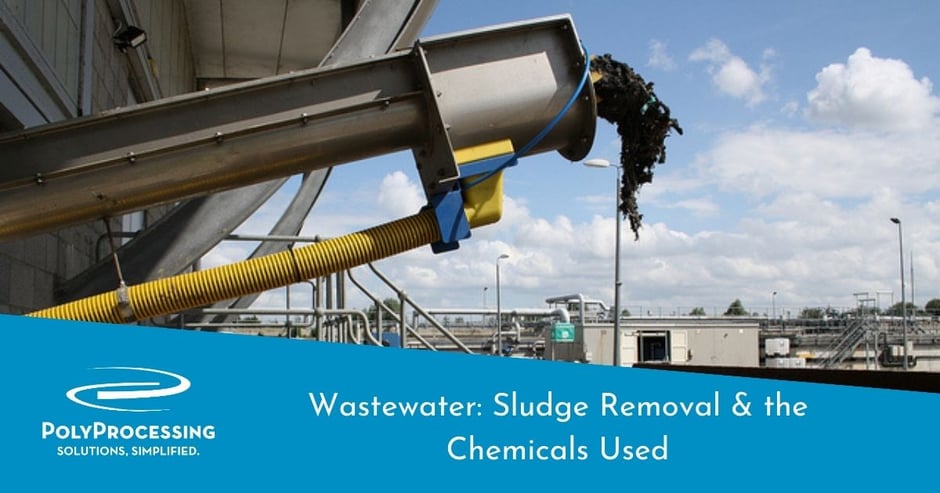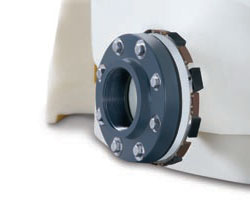Wastewater: Sludge Removal & the Chemicals Used
Wastewater treatment involves several key components: physical treatment (i.e. screening and filtering processes), biological treatment (i.e. oxidation ponds and lagoons), and chemicals. The chemicals required for the water treatment process must be used more aggressively and in larger quantities for wastewater than municipal drinking water. As such, safe, proper storage for wastewater treatment chemicals is critical.

There are five basic steps for the wastewater treatment process, each of which involves a set of common chemicals. The steps are as follows: removal of solid particles, neutralization, odor control, disinfection, and sludge treatment and removal. The following details sludge removal and the chemicals used in the process.
Why Sludge Removal Is Necessary
Wastewater sludge is essentially the solid material that is left behind after the wastewater treatment process. This sludge solid is made up of things like bacteria, organic matter, and other particles that were removed from the water during treatment.
Removing the sludge is an important part of the wastewater treatment process because it helps to prevent the buildup of potentially harmful materials and keeps wastewater treatment systems running smoothly. There are a few different methods for removing sludge, including gravity thickening, aerated stabilization, and centrifugation, among others.
Gravity thickening involves using gravity to separate the sludge from the water, which can be done in large tanks or basins. Aerated stabilization involves introducing air into the sludge to help it break down and become more stable, while centrifugation involves spinning the sludge to separate it from the water.
Wastewater treatment produces sludge in both on-site (i.e. septic tank) and off-site (i.e. activated sludge) systems. As wastewater treatment takes solids out of the wastewater, it is inevitable that there will be sludge remaining. Sludge characteristics can vary significantly from fairly fresh fecal materials, which contain large quantities of pathogens, to fecal matter that has decomposed over the course of the year, which contains much fewer pathogens, as many of them have already died off. The treatment required for the sludge is highly dependent on the specific characteristics.
Before sludge goes through its final disposal, it must be treated to bring down the volume and stabilize the organic materials. Stabilized sludge does not have a harsh smell and can be handled without risk of safety hazards. With a smaller volume, the costs for storing, pumping, and disposing of the sludge are less.
Wastewater Sludge Removal Options
There are various options for treating sludge including stabilization, thickening, dewatering, drying, and incineration. The costs for treating sludge and removing sludge from wastewater are roughly the same. Typically a polymer chemical is used for the volume reduction process known as dewatering. Polymers are slippery chemicals, which means that there is always a risk of slipping or falling due to spills and leaks. Polymers can also be environmental stress crack agents.
Dewatering decreases sludge liquid volume as much as 90 percent. Digested sludge is put through large centrifuges that work in the same fashion as a washing machine spin cycle. The spinning centrifuge produces a force that separates the majority of the water from the sludge solid, creating a biosolid substance. Then the water pulled from the spinning is sent back to the plant for reprocessing. Adding polymer chemical to the substance improves the consistency, creating a firmer product that is easier to manage. The biosolid cake consists of between 25 and 27 percent solid material.
How To Store Polymers Used for Sludge Removal
A cross-linked polyethylene vertical tank or sloped bottom design with an IMFO® system is optimal for sludge control polymers and offers simple, stress-free cleaning because the tank discharges / drains at the true bottom of the sidewall.
Advantages of IMFO®
- Full tank discharge, because the flange is at the bottom of the sidewall, below the tank knuckle radius. There’s no need to enter the tank for cleaning.
- Enhanced long-term performance and fuller useful life of the tank since the flange doesn’t compromise the tank’s hoop integrity or structural design.
- Complete flange face protection is available in aggressive oxidation environments. The antioxidant OR-1000™ system can protect the discharge components from deterioration.
- Highest amount of static head pressure. The IMFO’s design brings you the highest net positive suction head (NPSH) of any vertical non-coned tank on the market.
- Any required maintenance is simple and hassle-free. Unlike metallic inserts, the flange extends away from the tank wall and the entire flange system is external with easy hardware access from outside the tank.
- There are no chemical compatibility issues like the ones you may encounter with metallic inserts. If the chemical is safe in a crosslinked polyethylene tank, it’s safe discharging out of the IMFO system.
The tank's cross-linked construction enables increased expansion and contraction while keeping structural integrity, decreasing the risk of tank failure. Heat pads and insulation can assist with keeping chemicals at the proper temperature, substantially decreasing the possibility of separation and settling. A mixing system can also be installed to reduce the incidence of chemical separation.
If you are using chemicals for sludge removal in wastewater treatment, we have solutions to address your chemical storage needs.
Download our comprehensive guide on chemical storage for wastewater treatment for full details.
- July 31, 2023
- Topics: Applications
About Poly Processing
Posts By Topic
Tech Talk Podcast Episodes
Subscribe By Email
Recent Posts
- Installation Tips for Chemical Storage Tanks: Site Preparation and Offloading
- Understanding pH and Chemical Concentration When Choosing a Chemical Tank
- Maximizing Fill Efficiency: Selecting the Optimal Fill Line System
- Chemical Storage Tanks: A Quick Guide for End Users
- Popular Customization Options for Chemical Storage Tanks
Tank Configurator

Find the recommended tank and system components for your chemical storage challenge.
Configure a Tank Package








